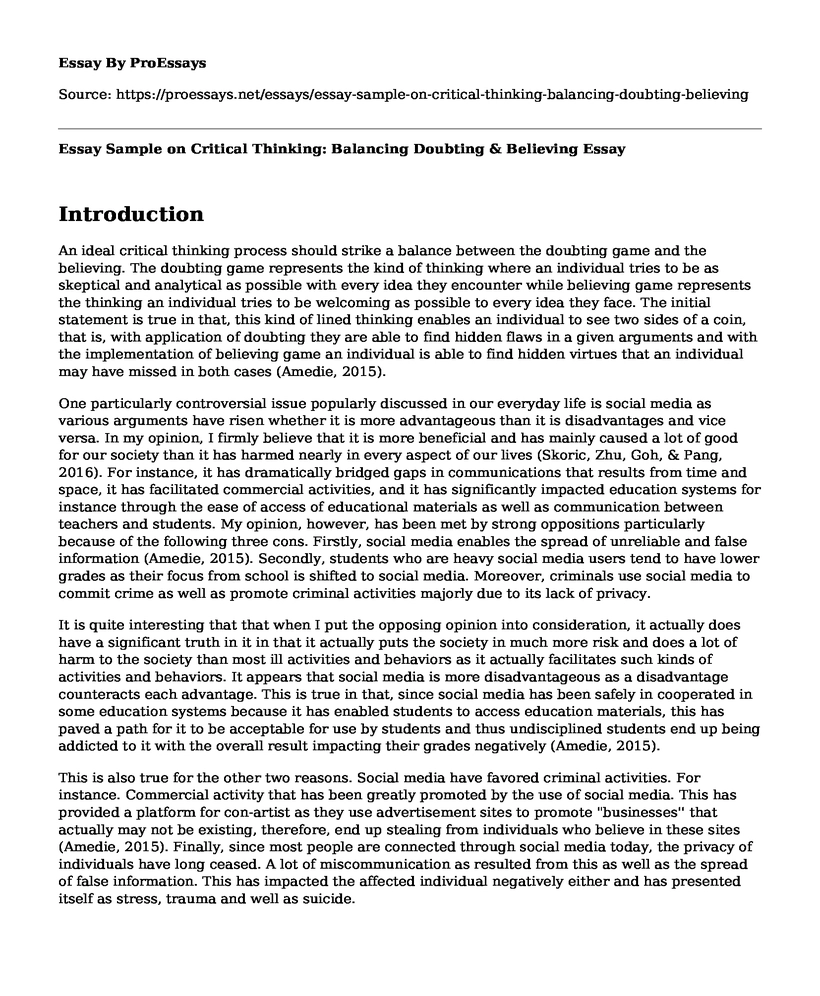Introduction
An ideal critical thinking process should strike a balance between the doubting game and the believing. The doubting game represents the kind of thinking where an individual tries to be as skeptical and analytical as possible with every idea they encounter while believing game represents the thinking an individual tries to be welcoming as possible to every idea they face. The initial statement is true in that, this kind of lined thinking enables an individual to see two sides of a coin, that is, with application of doubting they are able to find hidden flaws in a given arguments and with the implementation of believing game an individual is able to find hidden virtues that an individual may have missed in both cases (Amedie, 2015).
One particularly controversial issue popularly discussed in our everyday life is social media as various arguments have risen whether it is more advantageous than it is disadvantages and vice versa. In my opinion, I firmly believe that it is more beneficial and has mainly caused a lot of good for our society than it has harmed nearly in every aspect of our lives (Skoric, Zhu, Goh, & Pang, 2016). For instance, it has dramatically bridged gaps in communications that results from time and space, it has facilitated commercial activities, and it has significantly impacted education systems for instance through the ease of access of educational materials as well as communication between teachers and students. My opinion, however, has been met by strong oppositions particularly because of the following three cons. Firstly, social media enables the spread of unreliable and false information (Amedie, 2015). Secondly, students who are heavy social media users tend to have lower grades as their focus from school is shifted to social media. Moreover, criminals use social media to commit crime as well as promote criminal activities majorly due to its lack of privacy.
It is quite interesting that that when I put the opposing opinion into consideration, it actually does have a significant truth in it in that it actually puts the society in much more risk and does a lot of harm to the society than most ill activities and behaviors as it actually facilitates such kinds of activities and behaviors. It appears that social media is more disadvantageous as a disadvantage counteracts each advantage. This is true in that, since social media has been safely in cooperated in some education systems because it has enabled students to access education materials, this has paved a path for it to be acceptable for use by students and thus undisciplined students end up being addicted to it with the overall result impacting their grades negatively (Amedie, 2015).
This is also true for the other two reasons. Social media have favored criminal activities. For instance. Commercial activity that has been greatly promoted by the use of social media. This has provided a platform for con-artist as they use advertisement sites to promote "businesses'' that actually may not be existing, therefore, end up stealing from individuals who believe in these sites (Amedie, 2015). Finally, since most people are connected through social media today, the privacy of individuals have long ceased. A lot of miscommunication as resulted from this as well as the spread of false information. This has impacted the affected individual negatively either and has presented itself as stress, trauma and well as suicide.
Conclusion
The above discussions clearly illustrate the importance of applying the doubting game and believe game when an individual encounter a situation that requires critical thinking. As a result, an individual can acquire an additional act of judgment and commitment. Therefore, this kind of thinking should be thoroughly be taught and developed.
References
Amedie, J. (2015). The impact of social media on society. Routledge
Skoric, M. M., Zhu, Q., Goh, D., & Pang, N. (2016). Social media and citizen engagement: A meta-analytic review. New Media & Society, 18(9), 1817-1839.
Cite this page
Essay Sample on Critical Thinking: Balancing Doubting & Believing. (2023, Jan 04). Retrieved from https://proessays.net/essays/essay-sample-on-critical-thinking-balancing-doubting-believing
If you are the original author of this essay and no longer wish to have it published on the ProEssays website, please click below to request its removal:
- Essay Example: PowerPoint and a Student's Academic Performance in the Classroom
- Articles Review on the Importance of Work Experience
- Parental Incarceration Impact on Child Behavior Paper Example
- Critical Essay: Should English be the Worlds International Language?
- Reading to Young Children: A Head-Start in Life Essay
- Essay Sample on Early Child Development: Caring for Vulnerable Children in Their Early Stages
- Essay on Prisoners vs Students: Who Gets Free Food?







